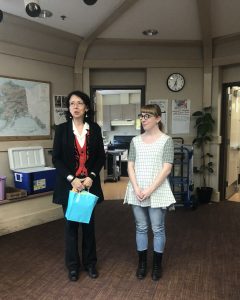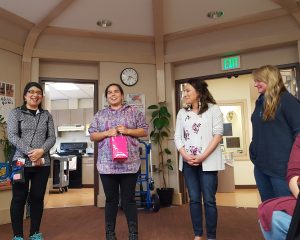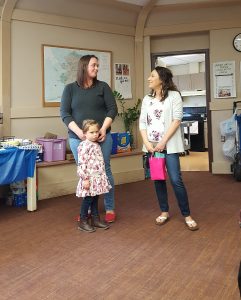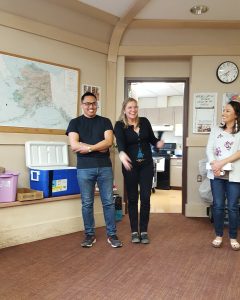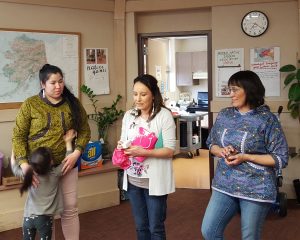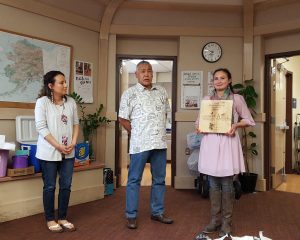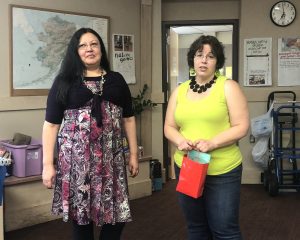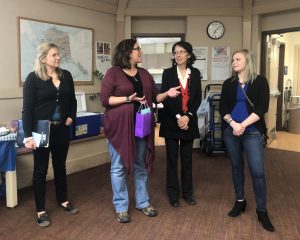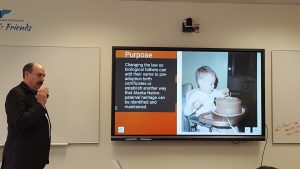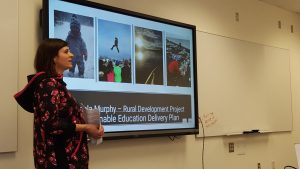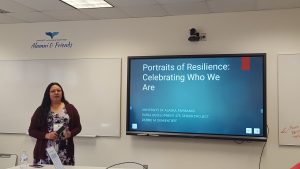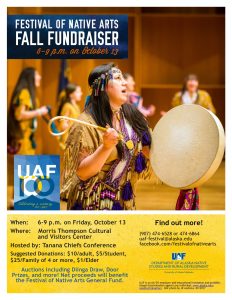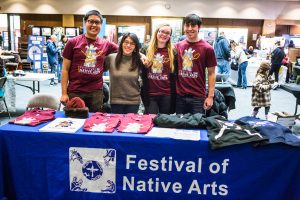There has been a lot of talk about “responsible development’ in Alaska recently. The Pebble Limited Partnership assured the public they will develop a “responsible’ plan for the mine.[1] The Alaska Delegation repeat the mantra that oil and gas development in the coastal plain of the Arctic National Wildlife Refuge (ANWR) will be “responsible development’. U.S. Secretary of the Interior, Ryan Zinke, just announced the “next step for responsibly developing the National Outer Continental Shelf Oil and Gas Leasing Program (National OCS Program) for 2019-2024‘.[2] Can we believe that the inclusion of responsibility will make these development projects acceptable?
If the justification for allowing development is down to paring it with responsibility we need to examine and understand what this actually means. What is “responsible development’, who does it and who holds them responsible to what standards? How far does responsibility extend?
Insisting that development will be “responsible’ allows everyone to walk away feeling good about the future. “We’ will do this “responsibly’ so everything will be OK. There will be no negative impacts on the environment or the wildlife that lives there because we will be responsible. People who never supported that development before can now feel comfortable. People who live far away will sleep easier knowing that only responsible development will take place in those remote pristine locations they value so highly but will likely never visit. Really though, should anyone be so complacent … should anyone actually believe that if responsible is hyphenated with development everything will be OK?
I worked in heavy industry for over twenty-five years and must question why we are suddenly talking about “responsible development’ when it has been my observation that most if not all industrial developers in this country already believe they are working responsibly. The discussion about developments such as ANWR drilling and Pebble Mine is not and should not have ever been about whether development will be responsible; it is about whether development should take place at all. For many years that was the focus of the argument and those who wanted to preserve the Refuge for its intended purpose were the winners because they held the stronger position. Rational people, including people like myself who were generally pro-development, understood that, no matter how responsibly people worked, there were risks inherent to industrial development that we simply should not take in some places. The Refuge is one of those places and the addition of responsibility has not changed that.
Ordinary citizens behave responsibly in response to something; a law, a custom, a social norm, a duty to family or community. We have a moral and/or legal obligation to behave correctly towards something or in respect of it.[3] Often we behave responsibly absent anything actually requiring us to do so; we may return lost items or assist strangers because we believe it is the “right’ thing to do and not doing the right thing would be irresponsible. How does this translate into responsibility for an industrial developer … to whom or what are they being held responsible and who is doing the holding?
Developers are held responsible to the laws and regulations of the jurisdiction where they are developing, and compliance will depend on the strength of the rule of law in that jurisdiction. They may be involved in activities related to “corporate social responsibility’ (CSR), but when it comes down to implementation of projects they will do what is required for legal compliance and no more. They will not be doing the corporate equivalent of voluntarily returning lost items or assisting strangers in the course of their development projects because nothing requires this, and doing so could even be construed as irresponsible use of assets by self-interested shareholders. To the contrary, if there is an accident or a broken law, corporations will be looking for ways to divest themselves of as much responsibility as possible as quickly as they can in order to protect their interest and those of their shareholders. We might examine how long Exxon spent fighting liability for the damages incurred by Alaskan coastal communities after the 1989 oil spill[4] or the way in which British Petroleum (BP) limited its responsibility (and billed the U.S. public by deducting court expenses as ordinary business costs on tax returns) after the Deepwater Horizon deep water drilling blow-out in 2010[5] to see how corporations address responsibility when an accident happens.
If the issue of direct responsibility for accidents is not enough to make us rethink development activities in areas where proper response is difficult or impossible, there is also the question of extended responsibility for things like climate change and air pollution resulting from the burning of the fossil fuels. When the Native Village of Kivalina brought federal suit[6] against multiple industrial defendants in 2008 in an effort to hold the industries responsible for their contributions to global warming, the suit failed. None of the defendants admitted any responsibility for the damage in Kivalina. More recently in 2017, three cases were filed in California state court that “seek to hold major fossil fuel companies liable for the effects of sea level rise they allege to be caused by climate change.’[7] Most current, in January 2018, New York City Mayor Bill de Blasio announced a lawsuit against five major oil companies that will seek to collect damages to pay for the cost of dealing with the effects of climate change on the City.[8] These suits seek to hold corporations responsible for the damage caused by the use of their products rather than any damage caused by extraction and it remains to be seen whether the courts will find that their responsibility extends that far.
Climate change is not the only area where responsibility should be questioned. Two new 2017 studies, from Imperial College, London, and UNICEF, “Impact of London’s road traffic air and noise pollution on birth weight: retrospective population based cohort study’[9] and “Danger in the Air: How air pollution can affect brain development in young children’[10] discuss the dangers that air pollution presents to unborn children. According to the Guardian, the studies found: “Air pollution significantly increases the risk of low birth weight in babies, leading to lifelong damage to health, according to a large new study. The research was conducted in London, UK, but its implications for many millions of women in cities around the world with far worse air pollution are “something approaching a public health catastrophe’, the doctors involved said. Globally, two billion children — 90% of all children — are exposed to air pollution above World Health Organization guidelines. A Unicef study also published on Wednesday found that 17 million babies suffer air six times more toxic than the guidelines.‘[11] Which companies, we must ask, will voluntarily admit responsibility for damage to unborn babies that results from the use of their products?
There is no real answer to what constitutes responsible development but one thing we know is that it will result in changes to the landscape and for the inhabitants. It also, in the case of minerals extraction, results in products that contribute in large amounts to human and environmental damage whether development is conducted responsibly or not. What do we really expect here from a “responsible’ company? Can we expect them to voluntarily restrict activities that will contribute to long term damage to the environment if no laws require them to do so? If we want to keep the bar for responsibility high we need to keep laws and regulations in place requiring this.
Responsible does not mean small; a very large development can be conducted in compliance with the law. Responsible has nothing to do with jobs; new projects do not require job creation. Responsible does not mean accident free; it means companies will make reasonable efforts towards prevention. It is unlikely that BP would admit to being irresponsible in their management of the Deepwater Horizon. Trans Canada, the owner-operator of Keystone pipeline that leaked 210,000 gallons of oil in November 2017[12] is not going to say they were being irresponsible in their maintenance of the line. If there is any “irresponsible’ behavior found it will be up to a judge in a court room to find it. The companies will say they were doing everything they were supposed to and the problem is, they are probably correct. This is why it is so important to question just what exactly the standard of responsibility is when a company is involved in development and make sure those standards are not reduced.
The Story of the Kulluk
For an Alaskan example of responsibility gone awry we can examine the grounding of the Kulluk offshore drilling unit while in transit from Unalaska to Seattle for repairs in December 2012. The National Transportation Safety Board (NTSB) Marine Accident Brief provides some information about responsible parties:
- Tow master, on board the Kulluk’•overall responsibility for controlling the movement of the Kulluk and operation of all assisting vessels during the tow, from unmooring in Alaska to mooring in Washington state, as well as interfacing with the Kulluk crew and other personnel
- Offshore installation manager (OIM), on board the Kulluk’•in command of the Kulluk
- Shell’s Alaska marine manager’•Shell shoreside manager, located in Anchorage; oversight responsibility for planning and managing Kulluk rig moves
- Aiviq master–in command of the dedicated tow vessel and its crew; legally responsible for the tow once the towline was made fast and the vessels were under way[13]
And: “The towing plan was developed by Shell’s Alaska marine manager and reviewed by the Aiviq master, the Shell Alaska operations manager, Alaska drilling manager, logistics team lead, health safety and environmental team lead, emergency response specialist, tow master, Noble Drilling Kulluk rig manager and operations manager for Alaska, and the GL Noble Denton warranty surveyor. The Shell Alaska operations manager was the final approval authority. Because he was on vacation at the time the tow plan was approved, a subordinate whom he had designated approved the tow plan in his place.’[14]
The NTSB Brief indicates that “The series of failures that led to this accident began when Shell failed to fully address the risks associated with a late December tow in Alaskan waters, and ended with the grounding of the Kulluk. Although multiple parties were involved in the review and approval of the tow plan, the ultimate decision to approve and implement the tow was Shell’s. The dynamics of a single entity approving a go/no-go decision in the face of risks, with multiple parties involved, have been addressed in studies of previous catastrophic events. This research demonstrates that, even with formal review processes involving multiple entities, the ability of parties involved in a decision to articulate and draw attention to risks is limited when a single entity bears ultimate decision-making responsibility and at the same time favors a particular outcome of the decision. For this reason, Shell, as the organization responsible for designing, approving, and implementing the tow plan, is considered to be ultimately responsible for this accident.’[15]
The Kulluk incident (in which there was no loss of life and no environmental damage) indicates that, even when many people involved are trying to be responsible accidents still happen. The Brief states “The potential hazards facing the transit were known. The day after departure, the Aiviq master wrote an e-mail to the Kulluk tow master stating, in part, “I believe that this length of tow, at this time of year, in this location, with our current routing guarantees an ***kicking.’[16] None of the responsible parties stopped the tow. Also of concern when we think about responsibility is the reason for the tow to Seattle; “Shipyard capabilities and equipment in the Seattle area were deemed more suitable for performing the Kulluk’s planned maintenance and repairs than facilities available in Alaska,…’[17] Is Alaska being irresponsible in encouraging offshore drilling activities when insufficient support infrastructure for maintenance and repair exists in the State?
Will companies volunteer responsibility?
Examining the track records of companies in other countries may also help us evaluate future responsibility. CSR may be prominent in the public relations materials on a corporate website but how are they actually behaving in other jurisdictions? Are they taking the moral high ground and conducting business the way we would want them to here, or are they involved in corrupt business practices because they can get away with it or because that is “normal’ in that country. The oil and gas industry lobbied to have the Trump administration repeal a Securities and Exchange Commission (SEC) regulation requiring oil and mining companies to disclose their payments to foreign governments in February 2017.[18] This action reversed much needed anti-corruption reforms regarding how the mining and oil and gas industries do international business and allows them to hide payments to national governments.
In case we think this would not concern us in Alaska let us remember that these multinational companies are doing business here. In November 2017 the Trump administration issued Eni US, a unit of Italy’s Eni, a permit to explore for oil from an artificial island in the Beaufort Sea.[19] ENI has a corporate governance section on its U.S. website and cites “integrity and transparency’ as their key principles.[20] The site makes no mention of ENI’s current involvement as a defendant on trial in Milan, Italy, against charges of corruption over a $1.3 billion oil deal in Nigeria together with Royal Dutch Shell.[21] While the outcome of the case may find both companies to be innocent of illegal dealings in Nigeria, their ongoing involvement in locations where corruption is the norm might raise some questions about the company’s commitment to integrity and transparency. Can we really expect companies that hide behind the “that is how they do business here’ excuse when accused of involvement in corrupt practices elsewhere to behave responsibly here unless laws make it very clear that they must? In the Kulluk incident, the NTSB Brief indicated that Shell might have incurred millions of dollars in state property tax had the Kulluk remained in Alaska into 2013.[22] Was Shell choosing responsibility to its bottom line over responsibility to the environment and the crews of the Kulluk and Aivik? They were not breaking any laws by proceeding with the tow.
If we are to be truly responsible to land and wildlife we will not allow industrial development in some locations at all. If we are responsible … and honest … we must admit that oil spills and industrial accidents are a part of the industry and, no matter how responsible companies are, they will happen. Down-stream effects of oil and gas development are inevitable; do we want to live with those? Some examples such as ocean plastics[23], ocean acidification[24] and severe air pollution[25] may be life threatening; do we want to make that choice?
If “responsibility’ does not eliminate spills and accidents, does not control size, guarantee jobs, or reduce pollution, and does not protect against corruption, then any development that takes place in ANWR will be business as usual, just like any other development. Is that what we want?
*Parts of this article were published in abbreviated form in the January 21st edition of the Fairbanks Daily Newsminer Community Perspectives entitled “Examining ‘Responsible Development’ of ANWR’
[1] Harball, Elizabeth. With new life under Trump administration, fresh Pebble Mine details released. Alaska Public Media. January 5th 2018 https://www.alaskapublic.org/2018/01/05/with-new-life-under-trump-administration-fresh-pebble-mine-details-released/
[2] Secretary Zinke Announces Plan For Unleashing America’s Offshore Oil and Gas Potential. U.S. Dept. of Interior Press Release January 4th 2018. https://www.doi.gov/pressreleases/secretary-zinke-announces-plan-unleashing-americas-offshore-oil-and-gas-potential
[3] https://en.oxforddictionaries.com/definition/responsibility
[4]Rosen, Yereth. Exxon Valdez oil spill saga reaches anticlimactic end in federal court. Anchorage Daily News. October 15th 2015. https://www.adn.com/environment/article/exxon-valdez-saga-reaches-anticlimatic-end-federal-court/2015/10/16/
[5] Laursen, Wendy. Winners and Losers in Deepwater Horizon Payout. The Maritime Executive. April 5th 2016 https://maritime-executive.com/article/winners-and-losers-in-deepwater-horizon-payout
[6] Native Village of Kivalina v. Exxon Mobil Corporation et al. 696 F.3d 849 (2012)
[7] https://www.lexology.com/library/detail.aspx?g=0ffacf4b-0828-4dab-8675-1d0ab3670f2e
[8] Neuman, William. To Fight Climate Change, New York City Takes On Oil Companies. January 10th 2018 https://www.nytimes.com/2018/01/10/nyregion/new-york-city-fossil-fuel-divestment.html?_r=0
[9] Toledano, Mireille B et all. Impact of London’s road traffic air and noise pollution on birth weight: retrospective population based cohort study Imperial College. November 2017 https://www.bmj.com/content/359/bmj.j5299
[10] Danger in the Air. UNICEF, Division of Data, Research and Policy, December 2017 https://www.unicef.org/environment/wp-content/uploads/sites/707/Danger_in_the_Air.pdf
[11] Carrington, Damian. Air pollution harm to unborn babies may be global health catastrophe, warn doctors. Guardian, U.S. Edition December 5th 2017. https://www.theguardian.com/environment/2017/dec/05/air-pollution-harm-to-unborn-babies-may-be-global-health-catastrophe-warn-doctors
[12]Gonzales, Richard. Keystone Pipeline Oil Spill Reported In South Dakota. NPR November 16th 2017. https://www.npr.org/sections/thetwo-way/2017/11/16/564705368/keystone-pipeline-oil-spill-reported-in-south-dakota
[13] NTSB Marine Accident Brief. Grounding of Mobile Offshore Drilling Unit Kulluk NTSB/MAB-15/10 pages 2 and 3
[14] NTSB Marine Accident Brief. Grounding of Mobile Offshore Drilling Unit Kulluk NTSB/MAB-15/10 page 3
[15] Id page 12
[16] Id page 5
[17] Id page 3
[18]C.K. Economist Blog February 17th 2017. Donald Trump signs a law repealing a disclosure rule for oil companies https://www.economist.com/blogs/democracyinamerica/2017/02/big-signing
[19] Gardner, Timothy. Trump administration permits ENI to drill for oil off Alaska. Reuters, November 28th 2017.https://www.reuters.com/article/us-alaska-oil-eni/trump-administration-permits-eni-to-drill-for-oil-off-alaska-idUSKBN1DS33B
[20] https://www.eni.com/en_NA/eni-north-america/eni-profile/corporate-governance/corporate-governance.shtml
[21]Reed, Stanley. Shell and Eni to Be Tried Over $1.3 Billion Nigerian Oil Deal. New York Times. December 20th 2017 https://www.nytimes.com/2017/12/20/business/energy-environment/shell-eni-italy-nigeria.html
[22] NTSB Marine Accident Brief. Grounding of Mobile Offshore Drilling Unit Kulluk NTSB/MAB-15/10 page 3
[23] Mathew Taylor. $180bn investment in plastic factories feeds global packaging binge. Guardian Tuesday December 26th 2017. https://www.theguardian.com/environment/2017/dec/26/180bn-investment-in-plastic-factories-feeds-global-packaging-binge
[24] James Ayre. Ocean Acidification Increasing Rapidly In Western Arctic Ocean. March 3rd 2017 https://cleantechnica.com/2017/03/03/ocean-acidification-increasing-rapidly-western-arctic-ocean/
[25] Shreya Goswami. If you’re pregnant, the pollution can seriously harm your baby. December 12th 2017. https://www.indiatoday.in/lifestyle/health/story/air-pollution-harmful-baby-pregnancy-exposure-birth-defects-health-lifest-1105517-2017-12-12

